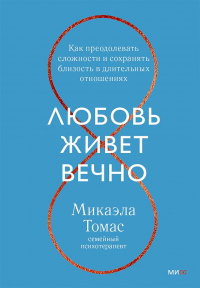Онлайн книга

Примечания книги
1
Gottman, J. M., & Silver, N. (1999). The Seven Principles For Making Marriage Work. New York: Harmony Books.
2
Buettner, D. (2012). The Blue Zones National Geographic.
3
Fisher, H. (2004). Why We Love New York: St Martin’s Griffin.
4
DeKoven Fishbane, M. (2013). Loving with the Brain in Mind. New York: Norton.
5
Gottman, J. M., & Silver, N. (1999).
6
Wax, R. (2018). How to Be Human. Milton Keynes, UK: Penguin Life.
7
Levine, A., & Heller, R. S. F. (2010). Attached. New York: TarcherPerigree.
8
Funk, J. L. & Rogge, R. D. (2007). Testing the ruler with item response theory: Increasing precision of measurement for relationship satisfaction with the Couples Satisfaction Index. Journal of Family Psychology, 21, pp. 572–583.
9
Gilbert, P. (2009). The Compassionate Mind. London: Constable.
10
Gottman, J. M., & Silver, N. (1999).
11
DeKoven Fishbane, M. (2013).
12
Eisenberger, N. I., Lieberman, M. D., & Williams, K. D. (2003). Does rejection hurt? An FMRI study of social exclusion. Science (New York, N. Y.), 302 (5643), pp. 290–292.
13
Doyle, G. (2020). Untamed. London: Vermilion.
14
Murphy, K. (2020). You’re Not Listening. London: Harvill Secker.
15
Hari, J. (2018). Lost Connections. London: Bloomsbury.
16
Curran, T., & Hill, A. P. (2019). Perfectionism Is Increasing Over Time: A Meta-Analysis of Birth Cohort Differences From 1989 to 2016. American Psychological Association, Psychological Bulletin 145, No. 4, pp. 410–429.
17
Harlow, H. & Zimmermann, R. (1959). Affectional Response in the Infant Monkey: Orphaned baby monkeys develop a strong and persistent attachment to inanimate surrogate mothers. Science 130 (3373), pp. 421–432.
18
Gottman, J. M., & Silver, N. (1999).
19
Matos, M., Duarte, C., Duarte, J. et al. (2017). Psychological and Physiological Effects of Compassionate Mind Training: a Pilot Randomised Controlled Study. Mindfulness 8, pp. 1699–1712.
20
Meevissen, Y. M., Peters, M. L., & Alberts, H. J. (2011). Become more optimistic by imagining a best possible self: effects of a two-week intervention. Journal of behavior therapy and experimental psychiatry, 42 (3), pp. 371–378.
21
Breines, J. G., & Chen, S. (2012). Self-Compassion Increases Self-Improvement Motivation. Personality and Social Psychology Bulletin, 38 (9), pp. 1133–1143.
22
Weng, H. Y., Fox, A. S., Shackman, A. J., Stodola, D. E., Caldwell, J. Z., Olson, M. C., Rogers, G. M., & Davidson, R. J. (2013). Compassion training alters altruism and neural responses to suffering. Psychological science, 24 (7), pp. 1171–1180.
23
Crocker, J., & Canevello, A. (2008). Creating and undermining social support in communal relationships: The role of compassionate and self-image goals. Journal of Personality and Social Psychology, 95 (3), pp. 555–575.
24
Gilbert, P., McEwan, K., Matos, M. & Rivis, A. (2011). Fears of compassion: Development of three self-report measures. Psychology and Psychotherapy: Theory, Research and Practice 84, pp. 23–55.
25
Hibberd, J. (2019). The Imposter Cure. London: Aster.
26
Gilbert, P., Clarke, M., Hempel, S., Miles, J. N., & Irons, C. (2004). Criticizing and reassuring oneself: An exploration of forms, styles and reasons in female students. The British Journal of Clinical Psychology 43 (Pt 1), pp. 31–50.
27
Dweck, C. (2017). Mindset. London: Robinson.
28
Compassion for Voices — animation by Charlie Heriot-Maitland, YouTube.
29
Harris, R. (2019). ACT Made Simple. Oakland, CA: New Harbinger.
30
Gottman, J. M., & Silver, N. (1999).
31
Winnicott, D. W. (1956). Primary maternal preoccupation. Collected papers, through paediatrics to psychoanalysis (pp. 300–305). London: Tavistock Publications, 1958.
32
Kabat-Zinn, J. (2004). Wherever You Go, There You Are. London: Piatkus.
33
Brown, B. TED talk. The Power of Vulnerability.
34
Francis-Tan, Andrew and Mialon, Hugo M., ‘A Diamond is Forever’ and Other Fairy Tales: The Relationship between Wedding Expenses and Marriage Duration (15 September 2014). Available at SSRN: https://ssrn.com/abstract=2501480 или http://dx.doi.org/10.2139/ssrn.2501480.
35
URL: https://luminalearning.com/personality-dynamics
36
Epstein, N. B., & Baucom, D. H. (2002). Enhanced cognitive-behavioral therapy for couples: A contextual approach American Psychological Association.
37
Radford, L. et al. (2011). Child abuse and neglect in the UK today. London: NSPCC.
38
Kabat-Zinn, J. (2004).
39
Baucom, D. H., Epstein, N., & Sullivan, L. J. (2004). Brief Couple Therapy. In Dewan, M., Steenbarger, B., & Greenberg, R. P. (eds), The art and science of brief therapies (pp. 189–227). Washington, DC: American Psychiatric Publishing.
40
Gurney, K. (2020). Mind the Gap. London: Headline.
41
Snyder, D. K., Baucom, D. H., & Gordon, K. C. (2007). Getting Past the Affair. New York: The Guilford Press.
42
Boyd, D. & Bee, H. (1994). Life span development. Pearson.
43
Rodsky, E. (2019) Fair Play. London: Quercus.
44
Svanberg, E. Breaking Past Patterns. Онлайн-курс: URL: www.mumologist.com.
45
Perry, P. (2019). The Book You Wish Your Parents Had Read (and Your Children Will be Glad That You Did). London: Penguin Life.
46
Whisman, M. A., Uebelacker, L. A. (2003). Comorbidity of Relationship Distress and Mental and Physical Health Problems. In Snyder, D. K., Whisman, M. A. (eds), Treating Difficult Couples. Guilford Press.
47
Brown, B. Brené Brown on Blame (3 February 2015). RSA short animation of original talk, The Power of Vulnerability. URL: https://www.youtube.com/watch?v=RZWf2_2L2v8.
48
Brown, B. (2015). Daring Greatly: How the Courage to Be Vulnerable Transforms the Way We Live, Love, Parent, and Lead. Penguin Life.
49
Hermanto, N., & Zuroff, D. C. (2016). The social mentality theory of self-compassion and self-reassurance: The interactive effect of care-seeking and caregiving. The Journal of Social Psychology, 156 (5), pp. 523–535.
50
Reading, S. (2017). The Self-Care Revolution. London: Aster.
51
Silberstein-Tirch, L. (2019). How to Be Nice to Yourself. Emeryville, California: Althea Press.
52
Neff, K. (2011). Self Compassion. London: Hodder & Stoughton.
